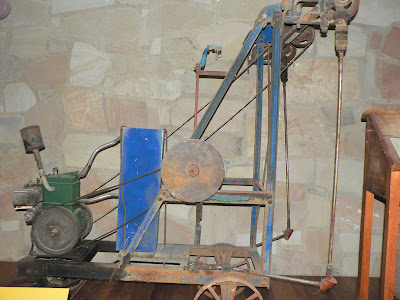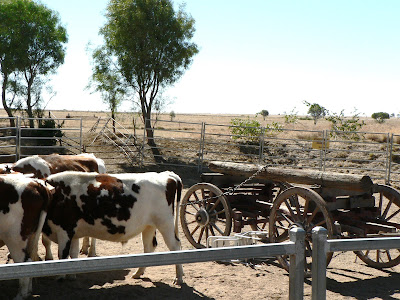Stockmen's Hall of Fame took 4 hrs to go through. A couple of floors of old artifacts given to the Hall of Fame on loaned from families for public exhibition. Some really great stuff in there & gives us a wonderful idea on how life was in the 1800 & early 1900's.
This wagon pulled by horses is from the 1860's, used by Hawkers, selling merchandise of every kind, incl 'knick-nacks'.
Sometimes the Hawkers were Afghans who came to Australia with camels. Immigration back then was even tight - no wives were allowed to come to Australia with their husband - so the Afghans usually married White or Aboriginal women
This is how a blacksmith's work area usually looked in the 1900's
The Furphy - named after it's inventer in 1878 - was used to carry water around
This really huge wagon was used to carry any large items of large quantities from A - B in the 1840's- 1880's. For eg. Wool bales weighing 300 - 450 lb each were stacked up 6 levels high. Because of it's total wt - 40 bullocks were used to pull it.
Rod's ht gives you an idea just how huge the wagon is.
Australia's millions of sheep were 1st shorn the hard way by hand shears as seen below photo - bottom tool. The advent of mechanical shears didn't come about until at least the 1870's - so shearers spent decades shearing sheep this way. The portable mechanical shearing stand (above) was used extensively by pastoralists to get the job of shearing sheep out in the paddock if necessary. Shearing sheds of up to 10 mechanical shearing stands existed in the early 1900's.
Photo above top to bottom - mechanical, dagging shears (pooey bits around the sheeps bum!), & the hand shears.
The next 2 photos are of how a kitchen looked in the 1920's. Note there's no fridge - just that box item with mesh around it to keep the flies away seen at the back.
The kitchen sink bench is made of wood.
Communication started out as morse code between 1 grazing property & another & usually for emergencies in the 1920's. Then the advent of the telephone with 'party' lines being common - other stations could listen in to other peoples conversations hence how word / gossip spread like wild fire - 1 telephone line connected to the exchange in town would serve several properties. My fathers property near Charleville had a 'party' line in up to the late 1960's - our ring number would be different to a neighbours, so we knew who the call was for.
An old radio
Plaited leather shoes were a luxury.
Part of the visit to the Hall of Fame included a stockmans exhibition of how pastoralist used his horse, his dog to round up sheep, a camel that became useful in some ways & of course the bulocky team demonstration.
Trusty horse
This old camel sang with his owner!
8 bullocks were used for the purpose of how useful they were.
These tethered bulocks stood up to this fellows shoulders - that's 1 tall cow!!
They gave a live demo of how a heavy log could be loaded onto this wagon - I think their steaks would be as tough as boot leather.
These meager items is all the stock drover had in his / her possession whilst spending months on the road driving mostly cattle hundreds of miles from home for adgistment to other properties with better pastures in times of drought. Hence advent of the 'Stock Route'. The item on left is the stockmans 'swag'. The metal item just above the bottom sign is a cow de-horner! Women weren't allowed to work as drovers, so aboriginal women used to dress up as men so as to get jobs.





















No comments:
Post a Comment